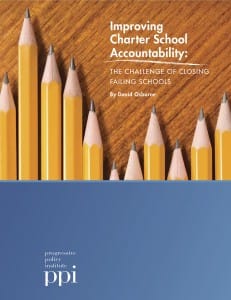David Osborne is one of America’s best thinkers on matters of government and governance and his expertise is on display with his latest paper, “Improving Charter School Accountability: The Challenge of Closing Failing Schools.” Cogently and concisely getting at the big issues facing the charter sector as it enters its third decade of educating children, this paper is an invaluable resource to those dedicated to improving the performance of the nation’s 5,500-plus charter schools.
 Osborne shows clearly that, despite the various warts and problems facing charters (and his paper deals with many of them), they “do outperform traditional public schools, while receiving almost 20 percent less money per student on average.”
Osborne shows clearly that, despite the various warts and problems facing charters (and his paper deals with many of them), they “do outperform traditional public schools, while receiving almost 20 percent less money per student on average.”
But, Osborne argues, the nation’s charter school sector must do better—and can if it focuses squarely on two main things:
- Replicating the most successful school models, and
- Closing the worst charter schools.
“Improving Charter School Accountability” tackles the second issue head-on by focusing on authorizer quality, the single biggest driver of charter school quality. Osborne writes, “Today, it is time to open a third frontier: authorizer quality. The key to quality in the charter sector is quality authorizing.” When I read this sentence I wanted to jump out of my chair and do a quick dance around my desk. Fordham has been arguing—with our friends at organizations like the National Association of Charter School Authorizers (NACSA) and the National Charter Alliance—this case since at least the mid-2000s, both in Ohio and nationally. The hard fact is that most people—and this includes lawmakers, policy makers, and others involved in setting education policy—have no idea what authorizers are, what they do, or why they matter.
Not surprisingly, as the work of authorizers is so little known and even less appreciated, it has not been done very well across the country. Osborne’s summary of the situation facing the nation’s authorizer community is largely a tale of limitations—limitations in political will, in money, in expertise, in data, in law, in performance, and in the capacity to do the job well. But, if the worst charter schools are to be closed and replaced with better options then authorizers need to be supported and bulked up as they are the entities with the authority—as imperfect as it may be—to actually take action against broken charters.
There are other reasons why it is so important to support and encourage authorizers in closing their weakest schools. Osborne shares the following:
- To protect the entire charter sector from being discredited.
- To protect taxpayers, we need to close charters that waste money.
- To ensure the continual improvement of the charter sector.
- To heighten competition and raise the bar on all schools.
"Closures are often controversial and messy, and most human beings prefer to avoid such pain."
Yet, Osborne notes, there is a fundamental disconnect between the logic and need for closing failed charters and the capacity and will of authorizers to actually do this work. Having been intimately involved with a few charter closures in Ohio I couldn’t help but sympathize with Osborne’s point that “Closures are often controversial and messy, and most human beings prefer to avoid such pain.” It is also expensive and, as Osborne notes, most states significantly underfund authorizers. Our experience bears that out: Fordham has been authorizing charter schools since 2005 and we have yet to have a year where our sponsorship costs haven’t had to be subsidized by our endowment or outside grant support.
It is because charter closures are costly and hard, I’d argue, that more and more quality authorizers are taking far more seriously the upfront decision of who to issue new school contracts to in the first place. Experience has taught many that it is far easier to say no to a prospective charter applicant than it is to say yes, and then be forced to close the school in five or six years. Quality authorizers are increasingly expert at hedging their bets, and this is why authorizers increasingly prefer sponsoring schools from successful networks or management companies. It is risky to authorize untested upstarts. This, of course, comes at the expense of innovation, which is another dilemma facing charter authorizers.
Osborne’s paper is a must read and does a fantastic job of shining a light on the need for better authorizers and the challenges of getting them. Even better, he provides a series of recommendations for how states can make progress in this important work. Maybe Osborne’s work on this important topic will motivate policymakers and charter proponents to recognize that the work of improving charters begins with improving their authorizers.
